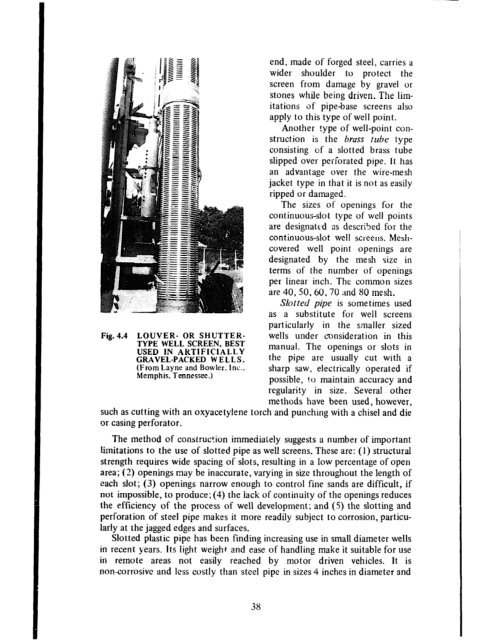Water Well Manual (USAID).pdf - The Water, Sanitation and Hygiene
Water Well Manual (USAID).pdf - The Water, Sanitation and Hygiene
Water Well Manual (USAID).pdf - The Water, Sanitation and Hygiene
Create successful ePaper yourself
Turn your PDF publications into a flip-book with our unique Google optimized e-Paper software.
Fig.4.4 LOUVER- OR SHUTTER-<br />
TYPE WELL SCREEN, BEST<br />
USED IN ARTIFIClALLY<br />
GRAVEL-PACKED WELLS.<br />
(From Layne <strong>and</strong> Bowler, inc.,<br />
Memphis, Tennessee.)<br />
end, made of forged steel, carries a<br />
wider shoulder to protect the<br />
screen from damage by gravel or<br />
stones while being driven. <strong>The</strong> lim-<br />
itations of pipe-base screens also<br />
apply to this type of well point.<br />
Another type of well-point con-<br />
struction is the brass tube type<br />
consisting of a slotted brass tube<br />
slipped over perforated pipe. It has<br />
an advantage over the wire-mesh<br />
jacket type in that it is not as easily<br />
ripped or damaged.<br />
<strong>The</strong> sizes of openings for the<br />
continuous-slot type of well points<br />
are designated as described for the<br />
continuous-slot well screens. Mesh-<br />
covered well point openings are<br />
designated by the mesh size in<br />
terms of the number of openings<br />
per linear inch. <strong>The</strong> common sizes<br />
are 40,50,60,70 ;rnd 80 mesh.<br />
Slotted pipe is sometimes used<br />
as a substitute for well screens<br />
particularly in the smaller sized<br />
wells under consideration in this<br />
manual. <strong>The</strong> openings or slots in<br />
the pipe are usually cut with a<br />
sharp saw, electrically operated if<br />
possible, to maintain accuracy <strong>and</strong><br />
regularity in size. Several other<br />
methods have been used, however,<br />
such as cutting with an oxyacetylene torch <strong>and</strong> punching with a chisel <strong>and</strong> die<br />
or casing perforator.<br />
<strong>The</strong> method of construction immediately suggests a number of important<br />
limitations to the use of slotted pipe as well screens. <strong>The</strong>se are: (1) structural<br />
strength requires wide spacing of slots, resulting in a low percentage of open<br />
area; (2) openings may be inaccurate, varying in size throughout the length of<br />
each slot; (3) openings narrow enough to control fine s<strong>and</strong>s are difficult, if<br />
not impossible, to produce; (4) the lack of continuity of the openings reduces<br />
the efficiency of the process of well development; <strong>and</strong> (S) the slotting <strong>and</strong><br />
perforation of steel pipe makes it more readily subject to corrosion, particu-<br />
larly at the jagged edges <strong>and</strong> surfaces.<br />
Slotted plastic pipe has been finding increasing use in small diameter wells<br />
in recent years. Its light weight <strong>and</strong> ease of h<strong>and</strong>ling make it suitable for use<br />
in remote areas not easily reached by motor driven vehicles. It is<br />
noncorrosive <strong>and</strong> less costly than steel pipe in sizes 4 inches in diameter <strong>and</strong><br />
38

















